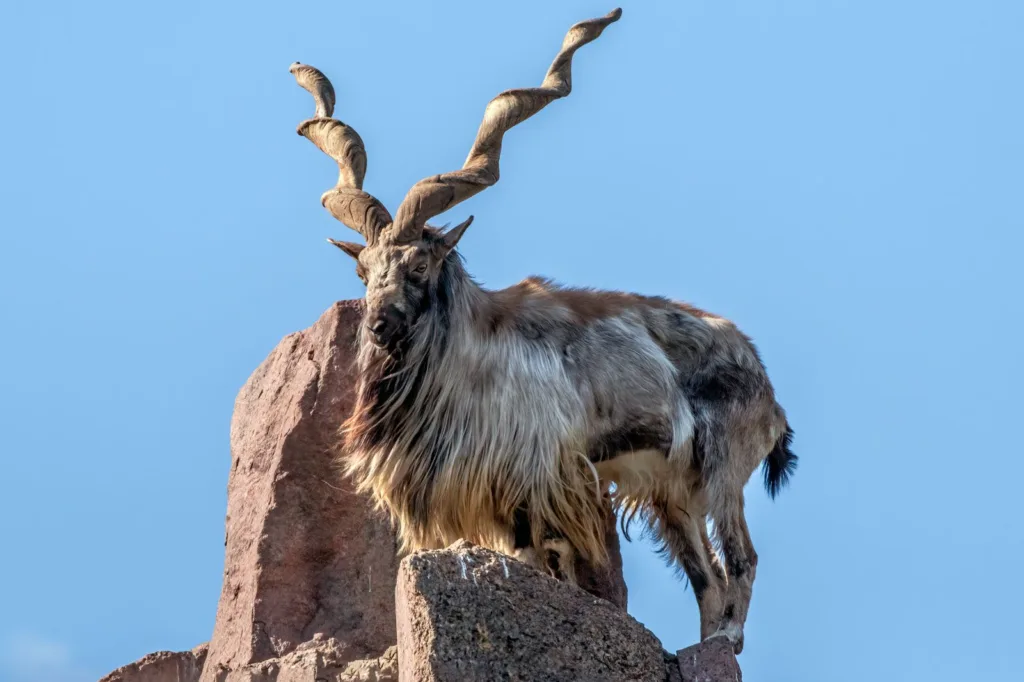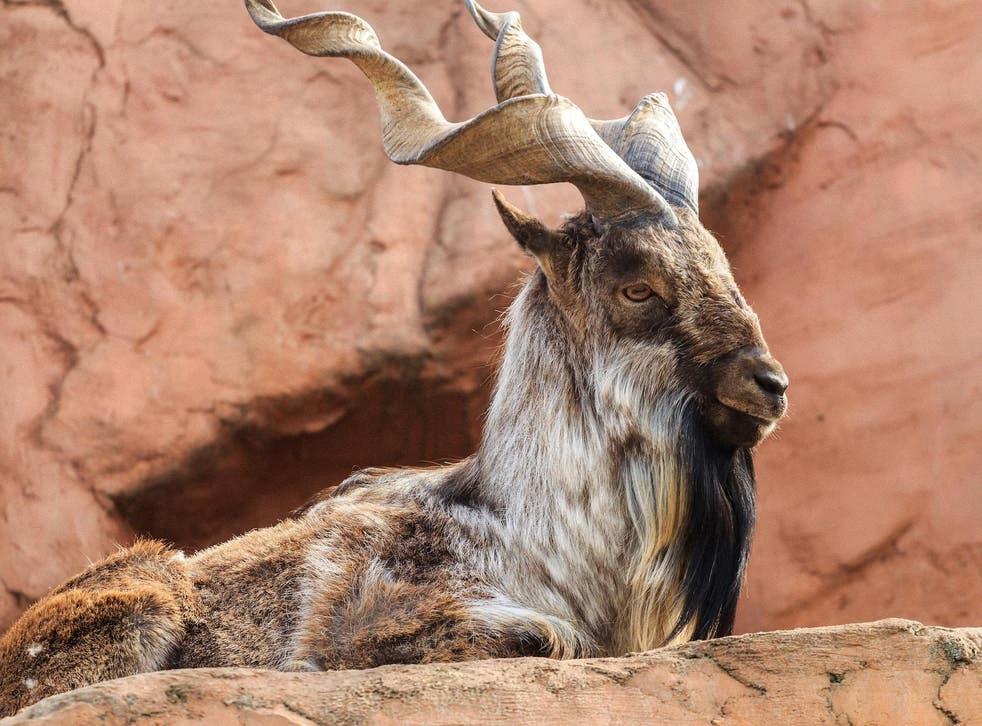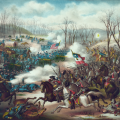The Markhor, also known as the screw-horned goat or Shakhawat, is a species of large, wild goat that is native to the mountains and high-altitude monsoon forests of western and central Asia. Five subspecies of this majestic creature exist in total, making it one of the most diverse species in its family. The markhor is the national animal of Pakistan, where it is also known as the screw horn or “screw-horned goat”, mārkhor (مارخور) in Urdu from Classical Persian.
In terms of its physical characteristics, the markhor stands out due to its impressive horns. Its horns can reach lengths up to more than 150 cm (59 inches), making them long enough to nearly span across its body when curved. This gives it an instantly recognizable profile and makes it quite unique amongst large mammals. Its fur also has a distinct look since its coloring ranges from yellow-brown to blackish-gray with white patches on its chin, throat and chest.
Markhors live in small herds and feed mostly on grasses, shrubs and foliage while they migrate between different habitats depending on the season. They are considered diurnal animals which means they are most active during daylight hours but will rest during midday heat or when temperatures drop significantly during night time hours.
Historically, markhors have been hunted for their meat for centuries by local tribesmen in Pakistan who depend on them for sustenance. Their meat is eaten throughout many countries in southern Asia and a 200-pound wild goat could provide quite a lot of sustenance for people who do not have easy access to other types of meat. However, hunting has been recognized as a threat to their population numbers so conservation efforts have been put into place over recent years by various organizations such as WWF Pakistan which have made sure that hunting quotas are respected and also implemented captive breeding programs for those animals which have been injured or oterwise unable to return to their natural habitats.
The name “Markhor” is an interesting combination of two Persian and Pashto words – “Mar” meaning snake and “khor” meaning eater – though there is no evidence that these magnificent creatures actually eat snakes or even kill them with their horns! Zoologists now either think that the legend comes from their ability to step on snakes and kill them with their powerful hooves or that their horns resemble the coiling of snakes!
All things considered, the markhor is truly an awe inspiring creature with a fascinating story behind it! It remains one of the most iconic symbols associated with Pakistan’s wildlife heritage and we can only hope that conservation efforts continue so that generations after us can still enjoy these incredible animals!
Is the Markhor a Goat or Deer?
Markhor is actually a type of wild goat, belonging to the Capra genus of the Caprini tribe. It is sometimes referred to as the “screw-horned goat” due to its long, corkscrew-shaped horns. Markhor can be found in mountainous regions of Afghanistan, India, Pakistan and Tajikistan. It is the national animal of Pakistan and plays an important role in their culture and history. The markhor stands at arund 60-90 cm at the shoulder and weigh up to 110 kgs. They have a shaggy coat that ranges from dark brown to black with white patches on the throat and chin. The horns can reach up to 160 cm in length, making them one of the largest horned animals in existence.

Is Eating Markhor Safe?
Yes, markhor meat is edible and can be used as a source of sustenance. Markhor are wild goats that are found in the mountainous regions of Afghanistan, Pakistan, India, Iran, Tajikistan, Turkmenistan and Uzbekistan. The meat from a 200-pound markhor can provide a substantial amount of nutrition for those who do not have access to other forms of protein. It is often cooked in stews or barbequed and served with rice or bread. The taste of the meat is described as similar to beef but with a more gamey flavor.
Do Markhor Consume Snakes?
Markhors, a type of wild goat found in the mountains of Central Asia, are not known to eat snakes. While there is a legend that markhors kill snakes with their horns, this has not been documented as fact and zoologists suggest that the legend may come from markhors’ ability to kill snakes with their powerful hooves or because their horns resemble the coiling of snakes. Markhors are herbivores and primarily feed on grasses and shrubs, though they will occasionally eat insects or small rodents.
The Meaning Behind the Name Markhor
Markhor is called markhor because of the combination of two Persian and Pashto words: “Mar” meaning snake, and “khor” meaning eater. The markhor is a species of large, wild goat native to the mountains and high-altitude monsoon forests of western and central Asia. Its horns are long, curved in a spiral shape which gives it the nickname “screw-horned goat” or “Shakhawat” in local languages. This powerful animal is renowned for its agility and strength as it can climb steep slopes in order to find food that would otherwise be inaccessible to oher animals. It is also an important cultural symbol for many local tribes and communities, representing strength, courage and perseverance.
Pakistan’s National Animal
Pakistan’s national animal is the Markhor, a species of wild goat that is found throughout the Himalayan Mountains in northern Pakistan. The Markhor has a long and shaggy coat of fur and is easily identified by its majestic spiral horns. The horns can grow up to 5 feet in length and are used for defense against predators. The markhor is an important symbol of Pakistani culture and pride, and it was officially declared as the national animal of Pakistan in 2018. The markhor population has increased due to conservation efforts, making it an even more important symbol of hope in Pakistan.

Source: independent.co.uk
The Benefits of Markhor Climbing Cliffs
The markhor is a wild goat species native to the mountainous regions of Central and South Asia. For centuries, it has been knon for its agility and ability to climb steep cliffs in pursuit of food or refuge from predators. Markhors are well adapted to climbing, with powerful hind legs and sharp hooves that allow them to grip the rocky surfaces. They are also able to jump up to 2 meters in height when fleeing danger.
Markhors typically feed on grasses, herbs, shrubs and lichens found in the high altitudes. By climbing cliffs, they gain access to areas where these plants are more abundant and easier to reach than on the ground. Additionally, they can find fresh young shoots of grass which provide more nutritious sustenance than older plant material on the ground. They also use cliffs as a means of protection from predators such as humans or bears who may be able to outrun them on level terrain.
In addition to seeking food and safety, markhors may climb cliffs for enjoyment or simply for the view from higher elevations. As diurnal animals, they take advantage of the morning sun that is often more intense at higher altitudes than lower down on the mountain side. They can also graze freely without fear of being disturbed by other animals or humans lower down in the valley below.
What is the English Name for Markhor?
The markhor (Capra falconeri) is a large goat native to the Central Asian region, Karakoram and the Western Himalayas. It is also known as the ‘screw horn goat’ or ‘Saharan’ in English and is the National Animal of Pakistan. The markhor has long, thick fur and a distinctive spiraling horns which can reach up to 160 cm in length. It stands up to 1 meter tall at the shoulder with males weighing up to 110 kg. Markhors feed mainly on grasses, leaves, lichen and various shrubs. They are active during the day and live in herds led by a dominant male.

Source: dawn.com
Estimating the Remaining Population of Markhors
According to the International Union for Conservation of Nature (IUCN), there are fewer than 2,500 markhors remaining in the wild. This number has been steadily declining due to poaching and trophy hunting, making the markhor an endangered species. The IUCN estimates that these animals could become critically endangered if conservation measures are not taken soon. As a result, it is essential that steps are taken to protect this species and prevent their numbers from further decreasing.
Are Markhors Found Outside of Pakistan?
No, Markhors are not only found in Pakistan. They can also be found in Afghanistan, India, Tajikistan, Uzbekistan and western China. Markhors inhabit mountainous terrains such as coniferous forests, grasslands and rocky areas. In India they are found in the states of Jammu and Kashmir, Himachal Pradesh and Uttarakhand.
The International Union for Conservation of Nature (IUCN) has listed the Markhor as an endangered species since 2003 due to its decreasing population size. Conservation efforts have been put in place to protect their habitats from overgrazing and poaching, with some success being reported in recent years.
Symbolism of the Markhor in Pakistan
Markhor is a wild goat species native to Afghanistan, Pakistan, India, Tajikistan, and Uzbekistan. It has been selected as the national animal of Pakistan due to its remarkable ability to adapt to the harsh environment of the mountainous region and wide distribution across the country. Markhor has a strong association with Pakistani culture and folklore. It is revered for its strength and resilience and is often seen as a symbol of perseverance in difficult times.
Markhor is also a popular symbol of bravery among the Pakistani people; it is believed that encountering this animal in its natural habitat brings luck. Furthermore, its presence in the country has helped to maintain the ecological balance of its habitat. Moreover, Markhor is an important source of income for many rural communities who rely on hunting this animal for subsistence. The government of Pakistan also recognizes the importance of this species and has taken measures to conserve it by provding protected areas where hunting is strictly prohibited.
In conclusion, Markhor has become an important symbol for Pakistan due to its deep cultural roots, ecological importance, and economic value for many rural communities across the country. It serves as a reminder of strength and resilience in difficult times and serves as an emblem of hope for many people in Pakistan.
Conclusion
The markhor is a unique and majestic animal that is found in the mountains and high-altitude monsoon forests of western and central Asia. It is the national animal of Pakistan, and its name is derived from Persian and Pashto words meaning “snake eater.” Markhors have been hunted for their meat, with a single 200-pound wild goat providing enough nourishment for many people in southern Asia. Although there is no evidence to support the legend that markhors eat snakes or kill them with their horns, zoologists believe this story may come from their ability to step on snakes with their powerful hooves or because their horns may resemble the coiling of snakes. With five subspecies existing throughout its range, the markhor remains an impressive species that deserves attention and respect.












